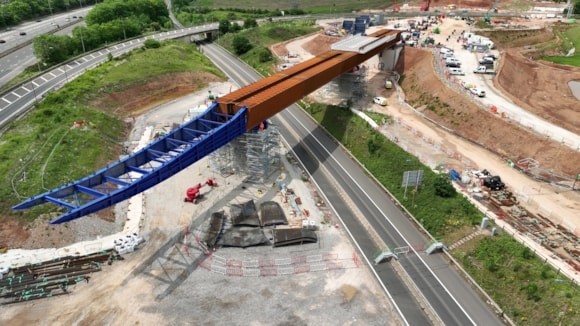Winvic Construction Ltd, a leading main contractor that specialises in the design and delivery of private and public sector construction and civil engineering projects has been appointed by Guildford Borough Council to deliver highways works to Weyside Urban Village, a new community that will comprise 1,550 new and affordable homes, along with green and play spaces, an employment space, commercial centre and sustainable transport hub. The first set of highways works began in early May 2025, with the remaining nine phases being delivered over an 18-month period, covering a variety of highways improvements. These include the reconfiguration of a roundabout, road widening schemes, residential parking bays, signalisation works, and the creation of a new toucan crossing. Dedicated bus lanes are also being introduced to improve service reliability and performance, encouraging the use of public transport, while a new network of cycle and footway facilities is being developed to encourage active travel. The scheme also features upgrades to the on and off ramps connecting the A3 to the A320, improving overall connectivity and reducing congestion across the area. The first set of highways works Winvic is undertaking is the construction of a new toucan crossing on Woking Road, replacing the existing uncontrolled crossing between Old Woking Road and Fir Tree Road. With works due to complete in August 2025, the upgraded crossing will help improve safety, allowing pedestrians and cyclists to cross at the same time. Winvic has been on site at Weyside since February 2024, delivering the on-site infrastructure works for the future residential development. Works included the preparation of plateaus for housing construction, and by the project’s completion in November 2025, approximately 34,000m³ of earthworks remediation will have been carried out to achieve the necessary ground levels. Diversionary drainage works began in October 2024, followed by the installation of around 4,500 metres of new foul, storm, and private drainage systems, including attenuation crates, and managing urban drainage using Sustainable Drainage Systems (SuDS). Winvic is also constructing 670 metres of internal roads and 1,300 metres of footpaths, complete with tactile crossing points. Throughout the works, Winvic will be actively engaging with the local community to deliver meaningful social value as part of its commitment to creating positive project legacies. This will include local employment, work experience and training opportunities, supporting STEM education by working with local schools and colleges through the Surrey Careers Hub, and volunteering initiatives. Rob Cook, Managing Director for Civils & Infrastructure at Winvic, commented: “We are proud to be working with Guildford Borough Council on the Weyside Urban Village project, which represents a significant investment in Guildford’s future that delivers vital infrastructure to unlock much-needed housing and promotes sustainable development and public transport solutions. Our involvement in both the on-site infrastructure and off-site highways works demonstrates Winvic’s capability to deliver complex, multi-phase, civil engineering projects with sustainability and social impact at the heart, that create long-lasting benefits for residents and the wider community.” Cllr Tom Hunt, Lead Councillor for Regeneration, said: “As we move forward with our plans to deliver the vital infrastructure needed to support the Weyside Urban Village regeneration, we’re pleased to have appointed Winvic Construction. Our strategic regeneration project will create new homes, jobs and green spaces, delivering on our commitment to make Guildford a greener, fairer, thriving place to live work and do business.” Keep up to date with the works at Weyside Urban Village here: Transport | Weyside Urban Village For more information on Winvic, the company’s latest project news and job vacancies please visit www.winvic.co.uk. Join Winvic on social media – visit X (Formerly Twitter) @WinvicLtd – and LinkedIn Building, Design & Construction Magazine | The Choice of Industry Professionals














